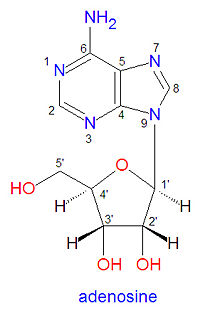Adenosine: Difference between revisions
imported>Ro Thorpe |
imported>David E. Volk (dA is not correct for this molecule, that is 2-deoxyriboadenosnie) |
||
| Line 6: | Line 6: | ||
|width=200px | |width=200px | ||
|molname=adenosine | |molname=adenosine | ||
|synonyms= | |synonyms=A, Ade, ADE | ||
|molformula= | |molformula= | ||
|molmass= | |molmass= | ||
|uses= | |uses= RNA | ||
|properties=nucleic acid | |properties=nucleic acid | ||
|hazards= | |hazards= | ||
Revision as of 19:15, 20 May 2008
|
| |||||||
| adenosine | |||||||
| |||||||
| Uses: | RNA | ||||||
| Properties: | nucleic acid | ||||||
| Hazards: | |||||||
| |||||||
Adenosine, is one of the nucleotides used to build RNA. It is also incorporated into DNA, but in DNA the ribose ring is a 2'-deoxyribose ring. In both DNA and RNA, adenosine is linked to the other nucleotides by phosphodiester bonds at both the 3'- and 5'- positions. In duplex DNA, the adenine base present in adenosine is hydrogen bonded with, that is, it forms a base pair with, a thymidine nucleotide on the opposite DNA strand.
Nomenclature
The structure of adenosine contains two distinct parts, the adenine base and the ribose sugar ring. Because of this, RNA and DNA nomenclature use numbers to describe atoms that are on the base ring while using primed numbers to describe atoms on the ribose ring (see figure). In DNA the 2'-carbon of adenosine is bound to two hydrogen atoms rather than one proton and one hydroxyl group.
